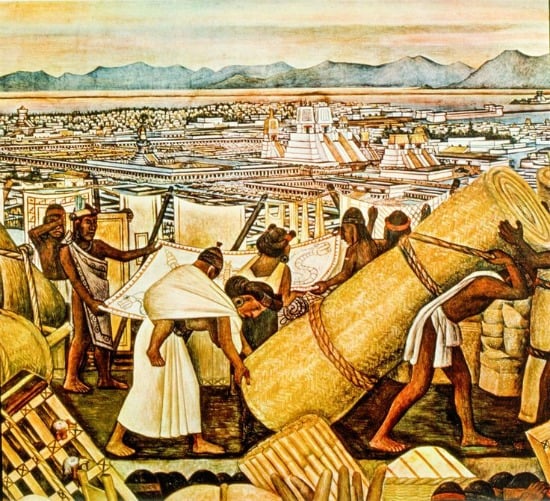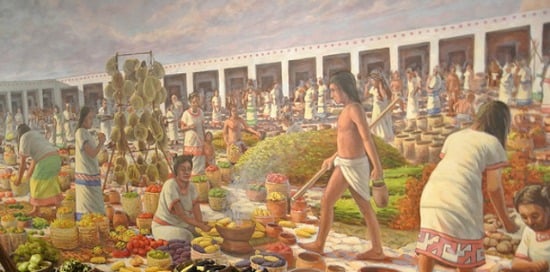by José Luis Mendoza Aubert
In this short essay, we will take a brief look at our beloved, historic, Mexican tianguis. We will, especially, put an end to the common conception that foreigners have that the tianguis is just a flea markets Well, no! Our humble tianguis, found throughout all of México, has a stunning and glorious past. Let's see.
A Pinch of History
In 1325, where now is Mexico City, the famed city-state, Gran Tenochtitlan was founded. (We do not know the month, or if it was founded in the morning or afternoon). The powerful Huitzilopoztli told the Mexica to spread across the four areas of the world; Cuepopan, Moyotlan, Zoquiapan and Atzacualco. As is always the case with we humans, by 1337 a group was not satisfied with the space that they had. So they decided to move, establishing a separate polity, settling between the lake and the reeds, on a sandy terrace, tlatelli, hence the name of Tlatelolco.
In those far away days, the Tenochcas or Mexicas controlled the ideological, political and economic power, while the Tlatelolcas controlled the trade. In 1428, after the release of the domain of Atzcapotzalco, the Mexicas were reorganized, moving the market of Tenochtitlan to Tlatelolco, giving rise to the largest and most important tianguis of the pre-Hispanic world.
The Tlacemananqui, specialized in trade, sold and exchanged their products at the great Tianguis of Tlatelolco. When more valuable products were on offer, cocoa, powder gold, copper tools or certain textiles were used as money.

The Tianguis
The Tlacemananqui were governed by their own laws, and were impressively well organized. Administrators and judges distributed the selling posts, organizing them according to products. In one area were those that sold all kinds of animals, including Xoloizcuintle (the Mexican dog) snake and deer. Another space was for vegetables and fruits; another for birds; another for clothes and tools, crockery, pots, pans, knives, bricks, etc. There were even color pigments for painters and craftsmen.
In another place were vendors with prepared food. Eateries featured fresh, handmade, corn tortillas, accompanied by a wide variety of stews with beans, corn, peppers, tamales, atole, opossum, deer, snake, etc. Let us not forget the rich diversity of insects, ants, worms, grasshoppers, frogs, termites, crayfish (river shrimps), as well as an extensive range of flowers, vegetables and fruits.
People gathered in the Tianguis of Tlatelolco, These included not only customers and vendors from all over the pre-Hispanic world, but anyone who wanted to know the latest news or rumor, to talk, exchange information, gossip, hear and make music, or just walk around. Also, parents brought their sons to choose among the young girls as future bride. The market day was convened every 20 days. With the arrival of the Spanish and their calendar, it was adjusted to once a week.
We can get an idea of the size of this market from the description Hernan Cortes sent, as part of the second report, to Emperor Charles V of Spain: "They have a square twice as large as the city of Salamanca, surrounded all around with portals, where there are all kinds of goods from all lands." Cortez's companion, Bernal Diaz del Castillo, wrote of the day he was accompanied by Montezuma and his entourage on his visit to the big market: "The great square was full with so many people and portals everywhere that in one day you couldn't see everything."

The Pochtecas
The journeying trading guild of the Pochtecas was hierarchical. Acceptance and advancement was based on merit and came with their respective ceremony. To join this legion, one had to be proposed by a member and then go into strict and arduous training.
Its members carried goods that were necessary for the townspeople, and brought back many luxury goods for nobles and emperor. They made each trip at great risk to their lives. They were leaving the limits of the empire for foreign lands where there would be a likelihood of being discovered by enemies, killed and robbed. Part of their mission was to gather intelligence, to spy for the Tlatoani governors.
They went as far north as the present day state of New Mexico, bringing from there feathers, puma skins, and articles and materials in general, for which they exchanged with the tribes up there. To the south they would trade with the Lacandon and Maya, going as far south as Guatemala and Central America. From those places they brought back quetzal feathers, textiles, jaguar and ocelot pelts and more.

The Table of Moctezuma
Our illustrious ancestor Don Motecuhzoma Xocoyotzin (The Young Lord Angered) had a very good, refined appetite. The king had a retinue of tamemes (porters) that ran in stages, like the Pony Express but without the horses. In this relay they brought him fresh fish from the Gulf of Mexico, in the state of Veracruz. It's a pity that there were no Olympic Games back then; Mexico surely would have won the marathon.
Also, these porters brought the snow from the volcano Popocatepetl. Having chosen the cleanest, they wrapped their frozen cargo in maguey leaves and then in a cotton blanket. The runner started down the volcano. After a strenuous course, before even catching his breath, his precious bundle was passed onto the back to the next shift. This relay continued for five long hours, ending with the delivery of the diminished cargo to the emperor's palace. The cook there unpack it carefully, revealing a still-substantial, pure white ball of snow. The royal chef portioned this out in gold cups, garnishing it with honey. Moctezuma was delighted with this exotic dessert, reserved only for him and some lucky nobles.
So that is a glimpse at our very Mexican institution, our tianguis, that continues to present time, despite the centuries and our modern, multinational supermarket chains and shopping centers. To buy in the tianguis is in our blood, in our genes, in our taste and our culture.
**************

José Luis Mendoza Aubert: actor, director and theater technician; teacher and writer of Theater and Plastic Arts; founder and director of the Comedia del Universo theater company and school, operating in San Miguel for the last 20 years; musicologist and cinephile, judge of the En Corto Film Festival now GIFF for 8 years; Director of Art and Culture of the Public Library for 15 years; member of the board of directors of El Sindicato Centro Cultural Comunitario.
José Luis gives talks and workshops on environmental awareness in schools and communities. He is a founding member of the Allende la Cultura Collective. He plays Veracruz music and writes poetry and is a founding member of the music group Jarocha "Soledad".
**************
*****
Please contribute to Lokkal,
SMA's non-profit community publication:
 ***
***
Discover Lokkal:
Watch the two-minute video below.
Then, just below that, scroll down SMA's Community Wall.
Mission

Visit SMA's Social Network
